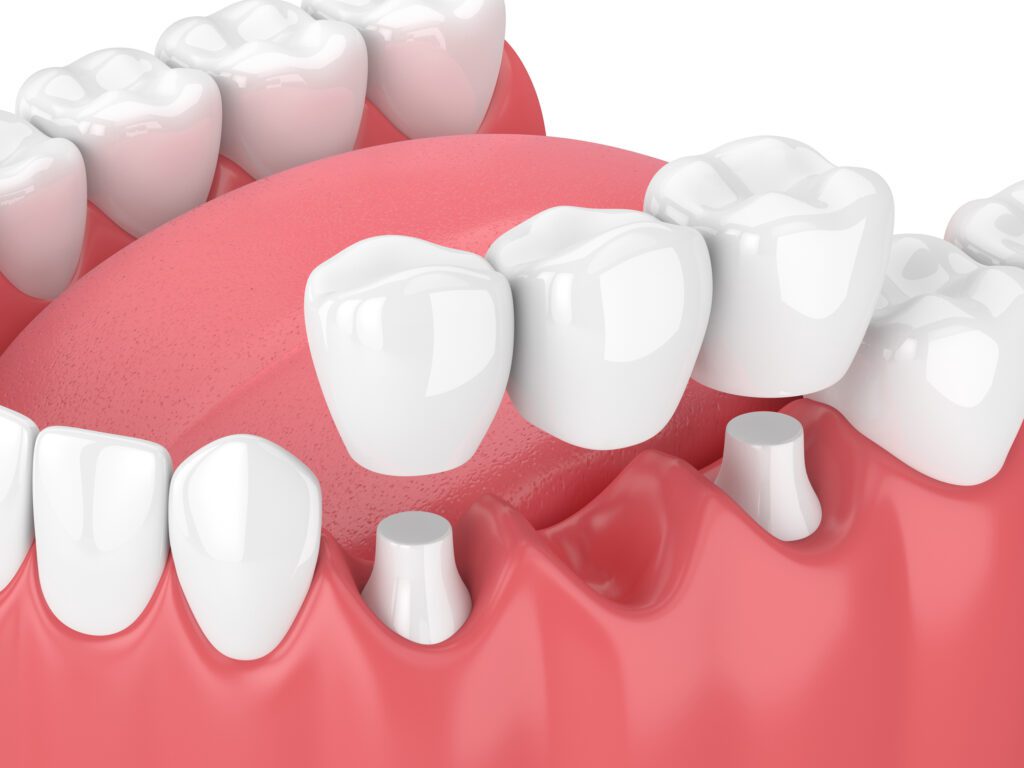If you’re dealing with missing teeth, severe tooth decay, or badly damaged teeth, it’s important to get your dental health back on track. One option your dentist may suggest is a dental bridge. This type of restorative treatment can replace one or more missing teeth and help restore both function and beauty to your smile. The team at Flower Mound Dental offers custom dental bridges for patients in Flower Mound, TX, helping to fill gaps from lost or damaged teeth.

What is a Dental Bridge?
A dental bridge is a device dentists use to replace missing teeth by “bridging” the space left by one or more lost teeth. The bridge includes one or more false teeth, called pontics, and is anchored by dental crowns placed on neighboring teeth or dental implants. These crowns secure the bridge, making it a stable, long-term solution.
Each bridge is custom-made to fit naturally within a patient’s mouth, blending in with the shape and color of surrounding teeth. This careful customization ensures the bridge feels comfortable and looks like your natural teeth.
A dental bridge has several important benefits, such as:
- Restoring Your Ability to Chew and Speak Clearly: Missing teeth can make it hard to chew food and speak. A dental bridge can help restore these functions, making it easier to eat a wide range of foods and speak without difficulty.
- Maintaining Facial Shape: When teeth are missing, the surrounding bone can start to shrink, which can change the shape of your face. A bridge can keep your facial structure intact.
- Preventing Teeth from Shifting: Teeth tend to move to fill empty spaces. This movement can cause misalignment, leading to issues with bite and more dental problems down the line. A bridge fills the gap, helping to keep your other teeth in place.
- Improving the Look of Your Smile: Gaps from missing teeth can affect your smile. With a bridge, you can regain a complete and natural-looking smile, boosting your confidence.
Types of Dental Bridges Available to Meet Your Needs
Our team will custom make a dental bridge for you that will meet your unique needs. Each meets meets specific needs based on the number of missing teeth and their location in the mouth. Here are some common types of bridges:
- Traditional Dental Bridge: This type has one or more pontics held in place by crowns attached to the teeth on each side of the gap. This is one of the most popular bridge options for replacing teeth in the back of the mouth.
- Cantilever Dental Bridge: A cantilever bridge is similar to a traditional bridge but only one crown anchors it, instead of two. This type works best when there is only one adjacent tooth available for support.
- Maryland Dental Bridge: The Maryland bridge uses a metal or porcelain framework that bonds to the back of the neighboring teeth. It has “wings” that cement to the adjacent teeth for support. This type of bridge is often used in the front of the mouth where less biting pressure occurs.
- Implant-Supported Bridge: Dental implants anchor this bridge type, rather than natural teeth. It involves placing implants surgically, which takes longer but provides strong support. An implant-supported bridge is ideal for cases where multiple teeth in a row are missing.
The Dental Bridge Process
The steps for getting a dental bridge depend on the type of bridge you need. Here’s a general outline:
- Preparation of the Anchor Teeth: If you’re getting a traditional, cantilever, or Maryland bridge, the dentist will need to prepare the anchor teeth. The dentist will reshape these teeth to fit the crowns that will hold the bridge in place. Your dentist will use local anesthesia to make sure you stay comfortable during this step.
- Taking Impressions: Once your teeth are prepared, the dentist will take impressions. The dental lab will use these molds to create both a temporary and a permanent bridge that fits your mouth perfectly.
- Fitting a Temporary Bridge: A temporary bridge will be placed to protect your prepared teeth while your permanent bridge is being made. This bridge allows you to eat and speak comfortably during the waiting period.
- Placing the Permanent Bridge: After a few weeks, your custom-made bridge will be ready. The dentist will remove the temporary bridge and secure the permanent one in place using special dental cement.
If you’re getting an implant-supported bridge, the process will be different and takes longer. The dentist needs to surgically place these implants in your jawbone, which requires a healing period before they can place the bridge.
Possible Downsides of Dental Bridges
While dental bridges offer many benefits, there are a few drawbacks to consider:
- Impact on Anchor Teeth: For traditional bridges, the dentist needs to remove a small portion of the enamel from the anchor teeth to fit the crowns. This process is not reversible, and it places extra pressure on these teeth. This may increase the risk of sensitivity, decay, or gum issues over time.
- No Replacement for Tooth Roots: Dental bridges do not replace the tooth roots. Tooth roots are essential for keeping the jawbone healthy, as they stimulate bone growth. Without roots, the bone in the area may start to shrink over time. Dental implants, however, can help prevent bone loss by acting as artificial roots.
How Long Do Dental Bridges Last?
With good care, a dental bridge can last anywhere from 5 to 15 years. Several factors affect the lifespan of a bridge:
- Oral Hygiene: Brushing and flossing daily are key to keeping the teeth and gums around the bridge healthy.
- Wear and Tear: Bridges in the back of the mouth endure more chewing pressure, which can shorten their lifespan compared to bridges in the front.
- Health of Surrounding Teeth and Gums: For the bridge to stay secure, the anchor teeth and gums must remain strong and healthy.
Eventually, you will need to replace the bridge as bone loss and normal wear occur. Maintaining regular check-ups with your dentist will help you get the most out of your bridge.
Frequently Asked Questions
We have answers to some of the most commonly asked questions concerning dental bridges.
Can I get a bridge if I have gum disease or sensitive gums?
You should treat and control your gum disease before getting a bridge. Healthy gums are essential for the bridge to stay stable and last. If your gums are sensitive but otherwise healthy, your dentist may still move forward with care and adjustments.
Are dental bridges safe for people with metal allergies?
Yes. If you have a metal allergy, your dentist can use metal-free materials like all-ceramic or zirconia. These options are durable, biocompatible, and still look natural, making them a safe alternative for sensitive patients.
Will a dental bridge look natural next to my other teeth?
Yes, a well-made bridge is custom-shaped and color-matched to blend in with your natural teeth. Once placed, it should be difficult to tell apart from the rest of your smile. Your dentist will design it to fit both functionally and aesthetically.
How soon after a tooth extraction can I get a dental bridge placed?
You’ll usually need to wait a few weeks for the gums and bone to heal before placing a permanent bridge. In some cases, a temporary bridge may be placed sooner for appearance. Your dentist will guide the timing based on how your mouth is healing.
Will a dental bridge change the way I speak at first?
It might, but only temporarily. You may notice slight changes in how certain sounds feel while your tongue adjusts to the new shape. Most people get used to it within a few days to a week, and speech returns to normal quickly.
Can a dental bridge be whitened if it becomes stained over time?
No, bridges don’t respond to whitening treatments like natural teeth do. If a bridge becomes stained, your dentist can clean and polish it during visits or replace it if the staining is significant. Whitening your surrounding teeth first helps ensure a good, long-term color match.
What happens if food gets stuck under or around the bridge?
You’ll need to clean around and under the bridge daily using floss threaders, interdental brushes, or a water flosser. If food stays trapped, it can cause gum irritation or decay around supporting teeth. Regular cleanings and good hygiene keep your bridge in good shape.
If you’re looking for a reliable solution to replace missing teeth, Flower Mound Dental offers custom dental bridges in Flower Mound, TX. Call us today at 972-691-8337 to request an appointment, or fill out our online form to get started on restoring your smile.
